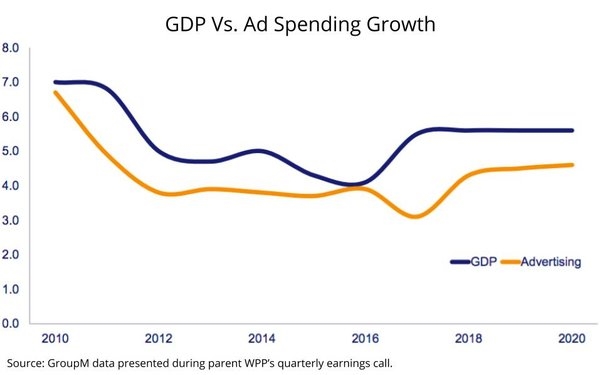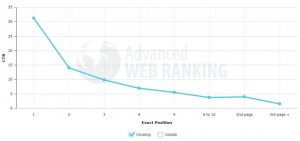How Digital Ad Spending Accelerates E-Commerce Growth, Why That Is Good For ‘Traditional’ Media

There were two essential pieces of intelligence about the media economy unveiled during WPP’s quarterly presentation to investors Thursday. You can find them on pages 39 and 43 if you want to download the 130-page deck, but we’ll give you the gist here.
The first one provides some insight about why the ad industry’s expansion has been lagging the growth of the overall economy. The second one explains how digital ad spending is accelerating an expansion of the global e-commerce marketplace.
With the exception of 2016, when advertising matched economic growth, the ad industry’s expansion has been lagging the global economy by about one percentage point, according to data presented by GroupM Futures Director Adam Smith.
The surface explanation is that ad budgets have failed to keep up or have been reduced relative to the economy, Smith said, adding that GroupM conducted an “investigation” revealing that economists may be “under-measuring” ad expenditures because the nature of advertising is changing. He suggested offered three systemic factors:
1 – The industry is doing a poor job of measuring growth in developing nations that account for much of advertising’s expansion. He said this could represent as much as $10 billion of missing ad spending in industry estimates.
2 – Digital budgets historically would have gone into “working media,” have instead been diverted into “technical expenditures” — technology used to process digital media buys, which account of about 19% of digital display and about 2% of paid search. He estimated that accounts for about $20 billion of advertising’s under-measurement.
3 – Lastly, and by far the most concerning, Smith said the balance is accounted for by the “compression of traditional advertising” and by brands diverting advertising budgets into promotional spending.
As disruptive as digital advertising’s expansion has been for measuring the industry’s economic growth, Smith presented a fascinating analysis showing its efficiency for stimulating global commerce — by a margin of two-to-one.
“Digital advertising is currently 8% of the volume of e-commerce,” Smith said, adding that GroupM’s current estimate is that will correlate to a 15% rise in e-commerce, bringing the global e-commerce market to $2.5 trillion in 2018, or about 10% of global retail sales.
That translates into real money, Smith said, noting that the “average Internet retail shopper in 2018 will spend just under $1,000,” representing a 10% increase in spending over 2017.
Here’s the important part of the correlation: Every 5% increase in Internet usage translates into a 10% increase in commerce. That happened in 2017 and Smith predicts it will happen again in 2018.
The bad news for big global brands and traditional media, he noted, is that much of that growth is coming from newer, “webendemic” brands that are using the Internet to launch new products and services that are offered “direct” to consumers.
“We have plenty of real-world evidence of nimble online challengers, flexitarians, picky Millennials, and delighting in the infinite shelf space of online,” Smith said, adding that there is some upside for traditional media outlets in these economics.
“When webendemics reach a point — it has been suggested it might be sales of $100 billion to $150 billion — they might need to investigate reach outside direct-to-consumer digital media to find further growth.”

MediaPost.com: Search Marketing Daily
(60)







